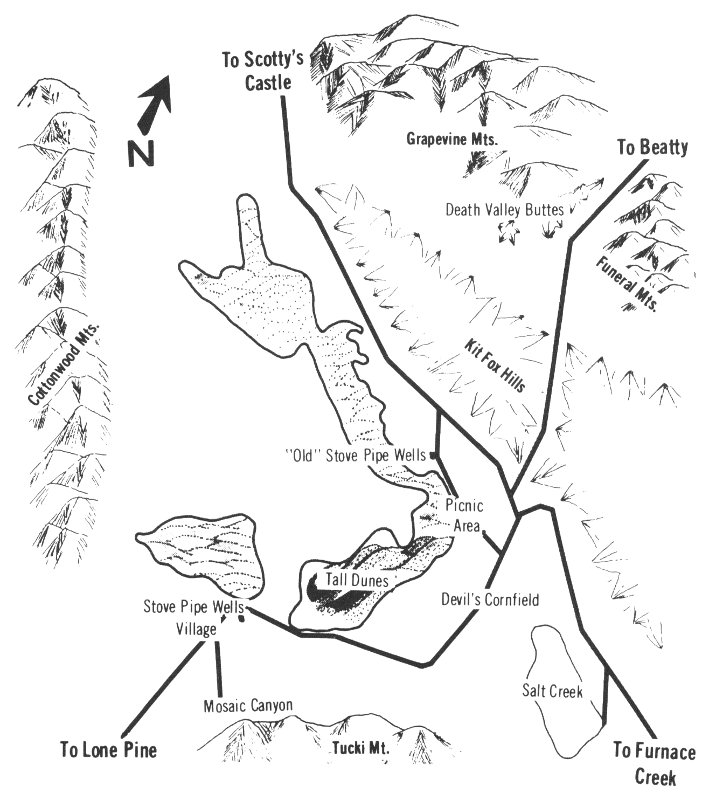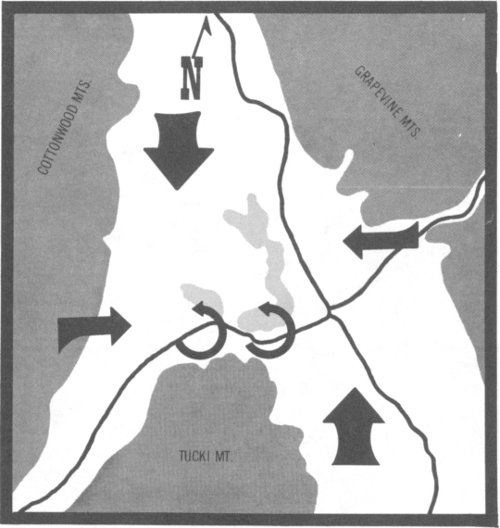
Sand Dunes Story
DONNA P. BESSKEN

- To Scotty’s Castle
- Grapevine Mts.
- To Beatty
- Death Valley Buttes
- Funeral Mts.
- Cottonwood Mts.
- Kit Fox Hills
- “Old” Stove Pipe Wells
- Picnic Area
- Tall Dunes
- Stove Pipe Wells
- Devil’s Cornfield
- Mosaic Canyon
- Salt Creek
- To Furnace Creek
- Tucki Mt.
- To Lone Pine
WELCOME!
What do YOU see as YOU look across the dunes? Piles of lifelesssand? A giant sandbox? Each of us sees the dunes differently. We wouldlike to share the story of the Death Valley Sand Dunes with you. Thisbooklet provides answers to some of your questions about the origin,composition and formation of the dunes. We will also look at the plants,and for evidence of animals that make their home here.
The features discussed are near the edge of the dunes and all youneed is your curiosity to explore this fascinating place. A magnifying glassor magnet may add to your enjoyment. Remember—the dunes can be hotin spring and fall as well as in summer months. Be sure to carry water,distance is deceiving, and a short stroll may become an extended walk. Doyou want to walk barefoot? Be careful around the bushes; thorns and plantdebris are hidden in the sand. Carry your shoes, your feet may get tired, orthe sand may become too hot. When you are in the shade, look around tosee if other creatures are sharing the same cool place. This is home for suchdesert dwellers as lizards, kangaroo rats and sidewinders.
There is no guided trail since wind can soon cover a trail with sand. It’seasy to find your way around and can be fun to choose your own route.Look behind you to get firmly in your mind which mountain feature will beyour landmark to guide you back to your vehicle.
To make the best use of this booklet, flip through it to locate topics ofinterest. Read in sequence, or follow the order of your discoveries. Useyour senses to appreciate and explore the sand dunes more fully. Pick upsome sand occasionally and compare the texture, temperature and otherqualities to that found in other locations. Be alert for little things—noticeplants, sand ripples, animal burrows and tracks.
Let’s walk into the dunes a short distance and learn their secrets. Toform sand dunes, three things are needed: wind, sand, and a place for thesand to collect. The story of the dunes involves interaction among thesefactors and the plants and animals that make their homes in this sea ofsand.
WHY ARE THE DUNES HERE?
Are they limited to this section of the valley? Do they migrate?Answers to these questions are in the winds.

Significant seasonal variations in wind patterns affect the dunes.
Winter and summer bring winds from different directions; northerly inwinter and southerly in summer. Landforms influence crosswinds andswirling wind currents (eddies). These crosswind and eddy pa